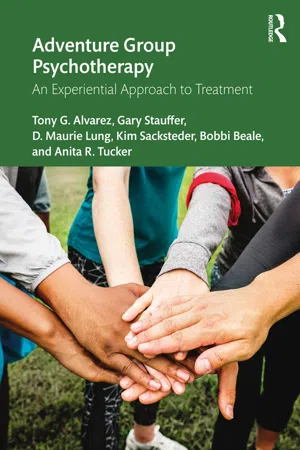
Adventure Group Psychotherapy
An Experiential Approach to Treatment
- 228 pages
- English
- ePUB (mobile friendly)
- Available on iOS & Android
Adventure Group Psychotherapy
An Experiential Approach to Treatment
About This Book
Adventure Group Psychotherapy: An Experiential Approach to Treatment explores what is necessary for an experiential therapy group to function effectively, and the practical skills needed to inspire success.
The authors describe how to use activities in a manner that produces the greatest opportunity for clients to reach their goals. Issues such as how to actively assess client functioning in the group, how to select the appropriate activity, how to shape an effective environment, and how to help clients process their experience are a few of the aspects examined to help clients move toward their goals. The practical skills the authors describe enable readers to immediately learn and apply their practice with groups.
This book will be an important tool in any group therapy class, in practice settings to train practitioners, and for any clinician trying to expand their group work capabilities.
Frequently asked questions
Information
1An Introduction
In the fall of 1995, after spending her summer attending a National Outdoor Leadership School 28-day backpacking course in the Pacific Northwest, one of the authors began her first year at the University of Michigan in her master’s in social work program. Although she had always loved the outdoors and experiential learning, at that point in her life, she had never thought of a career that would include them. One of her first classes at Michigan was called “Social Work in the Schools,” as she had really wanted to work with youth specifically in a school setting. About three weeks into the course, the professor of the course had all of the students go outside and began to present the activity for the day. In front of the graduate students he had laid a variety of different common items: two milk crates, several wooden 2×4s, a couple of chairs, and several mats from his car. At this point, the author remembers being completely confused but intrigued. The professor proceeded to explain to the class:Working in the schools can be both a challenging and fulfilling path for a career. In our work in the schools we will need to use a variety of resources and supports to help us on our journey [he points to the objects on the ground he had laid out]. Based on your understanding of social work in the schools, what things do you [the class] think will be needed to do that work?He proceeded to ask the class members to name the types of supports and resources they felt they would need to be successful; these responses were then written on masking tape and taped on the objects on the ground. Next he laid out two ropes in a line about 30–40 feet apart and explained that the class’s task was to move the entire group from behind the first rope across to the second rope without touching the ground, using only the resources they had (the objects). The class was told that they needed to keep in contact at all times with these objects and if any of the students lost contact with any of the resources, they would no longer have access to them (he literally would take them away). Finally, he said, “Any questions?”
References
2Foundations in Adventure Group Psychotherapy
Adventure Group Psychotherapy: Roots in Experiential Education
Adventure Therapy: What? So What? Now What?
What is Adventure Therapy?
Table of contents
- Cover
- Endorsements
- Half Title
- Title Page
- Copyright Page
- Contents
- About the Authors
- Acknowledgments
- 1 An Introduction
- 2 Foundations in Adventure Group Psychotherapy
- 3 Building Blocks of Adventure Group Psychotherapy: Moving Beyond Group Treatment Foundations with Experience
- 4 Overview of the Facilitated Wave
- 5 Guiding the Learning
- 6 Assessment
- 7 Matching
- 8 Shaping the Environment
- 9 Facilitating the Experience
- 10 Evaluating the Process
- 11 Concluding Invitation
- Appendix 3.1 Ethical Guidelines for the Therapeutic Adventure Professional
- Appendix 4.1 The Facilitated Wave: Full Model Overview
- Appendix 4.2 Action into Practice
- Appendix 6.1 The Four Corners Assessment Tool
- Appendix 7.1 Customizing Activities for Individuals on the Autism Spectrum
- Appendix 10.1 Evaluating the Experiential Process and Formal Evaluation
- Appendix 10.2 Adventure Therapy Experience Scale
- Appendix 10.3 Teamwork and Leadership Behavior Observation Checklist
- Appendix 10.4 Group Self-Evaluation Survey
- Index